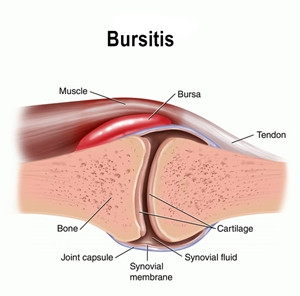Bursitis
Posted on July 4, 2018 by admin
Bursae are small, fluid-filled sacs that act as a cushion for the bones, tendons, and muscles around the joints. When they become inflamed, it is known as bursitis. Bursitis can occur in the shoulder, hip, elbow, and knee. Repetitive movements or positions that can apply pressure on the bursae, such as lifting something over your head repeatedly or kneeling on your knees for a long time can lead to bursitis. Inflammatory arthritis, an injury or a trauma can also cause bursitis. Someone who has bursitis will notice their joint becoming red and swollen. In addition, the joint will feel achy or stiff and they will feel pain when they try moving the joint or when they apply pressure to it.

Older adults, overweight individuals, and individuals with rheumatoid arthritis have a higher risk of developing bursitis. However, one can reduce their risk by warming up and stretching before exercising, strengthening their muscles, lifting properly, carrying lighter loads, and taking breaks after performing repetitive movements. Rest, ice, and exercises can help relieve the pain. A corticosteroid drug can be injected into the bursa to reduce pain and inflammation. The pain will disappear within a few weeks if it is treated properly.